| Columns Retired Columns & Blogs |
Conrad-Johnson CT5 line preamplifier Measurements
Sidebar 3: Measurements
As expected from its single gain stage, the CT5 inverted signal polarity. With the volume control set to "99," the preamp offered a maximum voltage gain of 19.2dB, which is on the high side for a line stage. The volume control didn't have an exact unity gain setting. A control setting of "78" was just below unity gain, "79" just above. The CT5's input impedance was close to 30k ohms across the audioband, while its output impedance was around 800 ohms as specified in the midrange and treble. However, it rose to 1836 ohms at 20Hz, meaning that the partnering power amplifier should have an input impedance of at least 20k ohms if the low frequencies are not to sound slightly lean.
The increase in output impedance gave a prematurely rolled-off bass into the worst-case 600 ohm load (fig.1, bottom traces below 100Hz), but the preamp's low-frequency response was superbly flat into the 100k ohm lab load (top traces below 100Hz). However, fig.1 also shows that the CT5's high-frequency bandwidth changes a little with load impedance. While the ultrasonic response is respectable into 100k ohms—the output is 3dB down at 103kHz—it increases by almost an octave into 600 ohms.
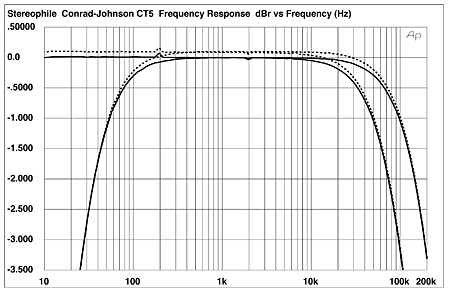
Fig.1 Conrad-Johnson CT5, frequency response at 1V into 100k ohms (top below 200Hz, bottom above 10kHz, and 600 ohms with volume control at "79"). (0.5dB/vertical div., right channel dashed)
The fig.1 traces were taken with the CT5's volume control set to just above unity gain ("79"). But, as with Conrad-Johnson's ACT 2, the CT5's bandwidth does depend on the volume-control setting. Fig.2 shows the preamp's response plotted with the volume control set to its maximum, "99," then in 5dB steps down to "69." The CT5's response is basically flat within the audioband at low control settings, though with the volume control at "99" the output is down a very audible 3dB at 17.8kHz. However, with the CT5's high voltage gain, I think I'm safe in saying that the volume control will never be used at a setting at which its HF response will be curtailed. Any softness to the sound will be overshadowed by the fact that the amplifier will by then be well into clipping!
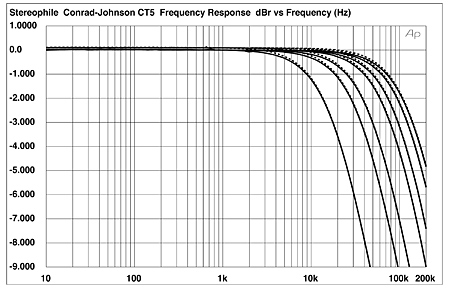
Fig.2 Conrad-Johnson CT5, frequency response at 1V into 100k ohms with volume control at (left–right): "99," "94," "89," "84," "79," "74," "69" (1dB/vertical div., right channel dashed).
Channel separation (fig.3) was good rather than great, at 72dB in both directions at 1kHz. Noise levels were low, the A-weighted signal/noise ratio (ref. 1V output with the volume control at "99") measuring 89.3dB. The wideband, unweighted figure was 66.7dB.
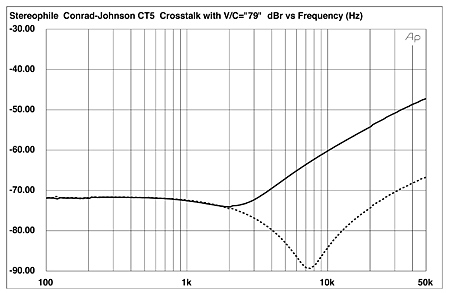
Fig.3 Conrad-Johnson CT5, channel separation (10dB/vertical div.)
Conrad-Johnson preamps have always been capable of very high output voltages, and the CT5 is no exception. Fig.4 plots the percentage of THD+noise in its output against output voltage. With clipping defined as 1% THD+N, the CT5 gives out 8V into 100k ohms or 6V into 10k ohms at clipping, both levels well above that required to drive the partnering amplifier to its full output. Only 1.5V are available into 1k ohm, an admittedly unrealistically low load for the CT5. Note the upward slope of the traces above the point where the actual distortion starts to rise out of the background noise. This is due to an increasing amount of waveform asymmetry as the signal level increases.
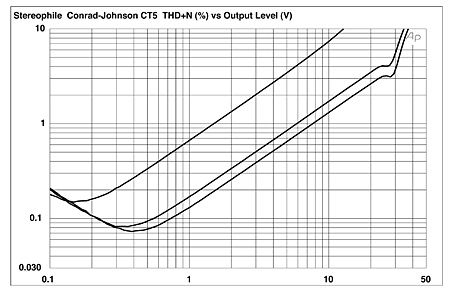
Fig.4 Conrad-Johnson CT5, distortion (%)vs 1kHz output level into (from bottom to top at 1V): 100k, 10k, 1k ohms.
Fig.5 plots the THD+N percentage at 1V output. Commendably, there is no rise in THD at the top of the audioband. But again, note the CT5's unhappiness at driving loads much below 10k ohms. The waveform asymmetry mentioned above suggests that the distortion content will be, predominantly, the subjectively innocuous second harmonic. That this is indeed the case is revealed by fig.6, which plots the spectrum of a 1kHz tone driven at 1kHz into a lowish load of 8k ohms. The second harmonic lies at –54dB (0.2%), the third and fourth harmonics below –100dB. Second-harmonic distortion is subjectively benign only if the "bent" transfer function that produces it does not also introduce excessive intermodulation distortion. Fig.7 shows the spectrum of the CT5's output while the preamp drives an equal mix of 19kHz and 20kHz tones at a peak level of 1V into 8k ohms. Even into this low impedance, the 1kHz difference component produced by the CT5 lay at a sufficiently low –60dB (0.1%), and all the higher-order components were much further down in level.
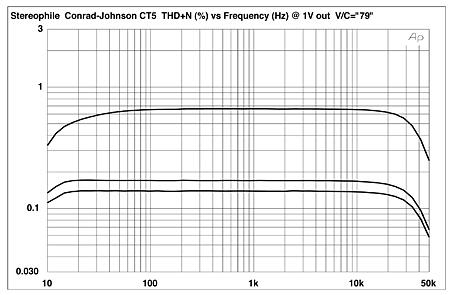
Fig.5 Conrad-Johnson CT5, THD+N (%)vs frequency at 1V into (from bottom to top): 100k, 10k, 1k ohms.
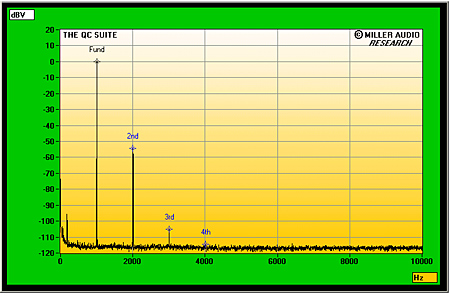
Fig.6 Conrad-Johnson CT5, spectrum of 1kHz sinewave, DC–10kHz, at 1V into 8k ohms (linear frequency scale).
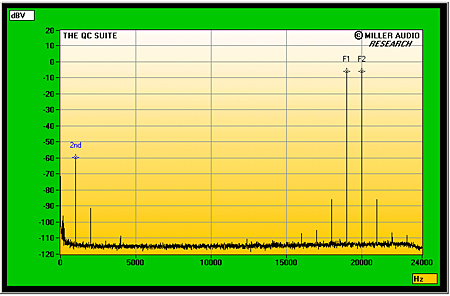
Fig.7 Conrad-Johnson CT5, HF intermodulation spectrum, DC–24kHz, 19+20kHz at 1V peak into 8k ohms (linear frequency scale).
The CT5 featured respectable lab performance, typified by high dynamic range and a distortion signature that will never be found offensive.—John Atkinson
- Log in or register to post comments




































